Contents
Daikon is a subspecies of the radish, which the Japanese bred a very long time ago. They eat this vegetable almost every day raw, boiled, salted, pickled or stewed. It is quite possible that it is he who contributes to the notorious Japanese longevity, since it contains a huge amount of useful substances. And Daikon Minowashi (or Minowase) is a whole group of mid-season varieties, among them there are those that do not respond to high temperatures that are resistant to diseases characteristic of radish. For us, they are so unusual and unknown that we consider them all to be one variety.
Variety description
“Daikon” means “big root”, the size of the root crop, indeed, has become the main difference between this vegetable and the radish we are used to. In 60 – 70 days from the moment of sowing, Minovasi grows a snow-white root crop, the length of which can be either 40 or 55 cm, and the diameter of the upper cylindrical part is 10 cm. It narrows downwards, and even the taste changes – due to the very small content of mustard oils, this relative is much more tender than the radish, the top of the root crop is sweet, and a slightly noticeable sharpness appears only at its sharp tip.
It forms a rosette of beautifully dissected leaves (there can be up to 40 pieces), of which the Japanese make an excellent side dish for salads or sushi, they also eat young shoots, especially since not a single part of this amazing plant accumulates harmful substances from the environment . We don’t see greenery on store shelves, because it quickly withers and turns yellow, losing not only its appearance, but also its taste and benefits, so only gardeners can regale on it.
As the root crop matures, it protrudes more and more from the ground, as if it is interested in what is happening on the surface, by the time it is harvested a quarter of its length (sometimes more), it rises above the level of the garden, covered from above with a lush hat of rather large leaves.
They grow it as a summer and as a winter version, the summer one goes to the table right away, but the winter one can be stored almost until the end of winter. Daikon does not like cold weather, he perceives a temperature of +10 as frost. But the long daylight hours (over 14 – 15 hours) love so much that he forgets to grow the root crop, immediately throws out the arrow. Therefore, they plant it either in the spring, as early as possible, or by the end of July (this is the winter version). The Minowashi Summercross variety came to us, which is resistant to shooting, here, according to reviews, it can grow all summer without scaring the gardener with a flower arrow.
The dense juicy pulp of the root crop contains a lot of vitamin C, sugar, proteins, dietary fiber, pectin, as well as a special enzyme that helps digest starch. It contains phytoncides and salts of many metals, B vitamins, beta-carotene, which enrich the body with the elements it needs. So potassium salts are involved in the removal of excess fluid, toxins and toxins, this vegetable helps to eliminate radiation and cholesterol, cleanses not only blood vessels, but almost all internal organs, and helps restore the proper functioning of the liver, kidneys and gallbladder.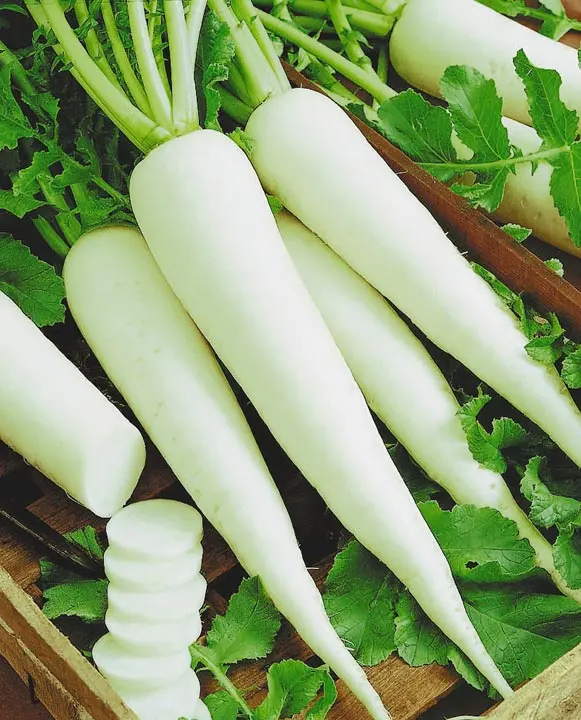
Its antibacterial and antiviral action helps to cope with respiratory diseases and even flu. But you need to be careful with its uncontrolled consumption for people who have serious problems with the gastrointestinal tract – during the period of exacerbation of gastritis, and especially ulcers, it is better not to abuse it or even consult a doctor first.
Video “What is Daikon”
From this video you will learn what this vegetable is, what is its use.
How to grow
Planting and care resemble a radish – it’s not for nothing that they are relatives. Daikon varieties with short, round roots are most often grown from seedlings, but Minowashi, with their long roots and long tender roots, do not like transplants and picks, so they are best sown directly into the ground. The soil should be light, loose, fertile and non-acidic. Daikon is not picky enough that it will grow in any soil, but the quality of the crop will correspond to the conditions that have been created for it.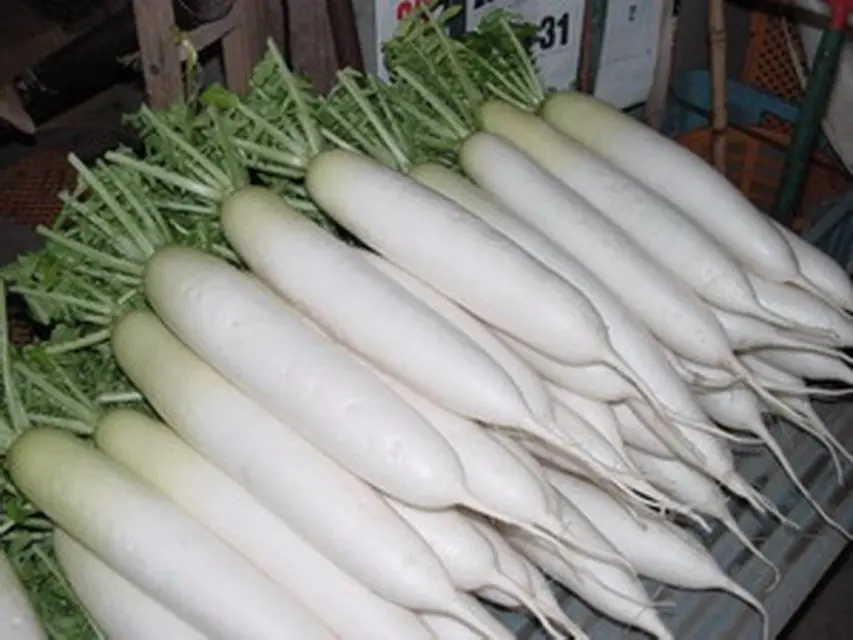
You can’t grow it after cruciferous relatives if planted in a garden after cabbage, radish or turnip, but no resistance laid down by breeders will save you from diseases, so it’s better not to risk it. The most successful predecessors are tomatoes, potatoes, cucumbers, beets and carrots. It is especially good if the garden bed is generously fertilized with organic matter under them. But even if they didn’t fertilize, then in the fall, after harvesting them, you need to carefully dig up the site, remove all weeds, roots, plant debris, add at least 2 kg of compost or humus per square meter, add ammonium sulfate, superphosphate and potassium sulfate. If the soil is acidic, then lime should be applied a couple of weeks earlier, and only then fertilizers.
It is very important to water the plants regularly – lack of watering will make the roots hard and bitter, and uneven watering will contribute to their cracking. On average, we can say that watering is done every five days, during a drought it needs to be done more often, and after rains – less often. The main thing is that the ground around the roots is always wet, drying out will have a bad effect on the quality of the crop.
Throughout the growing season, you need to make sure that there are no weeds around the plants, and the soil is loose enough, that is, it is necessary to weed and loosen it, and also spud root crops that will begin to actively crawl out of the ground. Spud plants to protect the future crop from accidental damage. Mulching with peat or compost will help facilitate the work.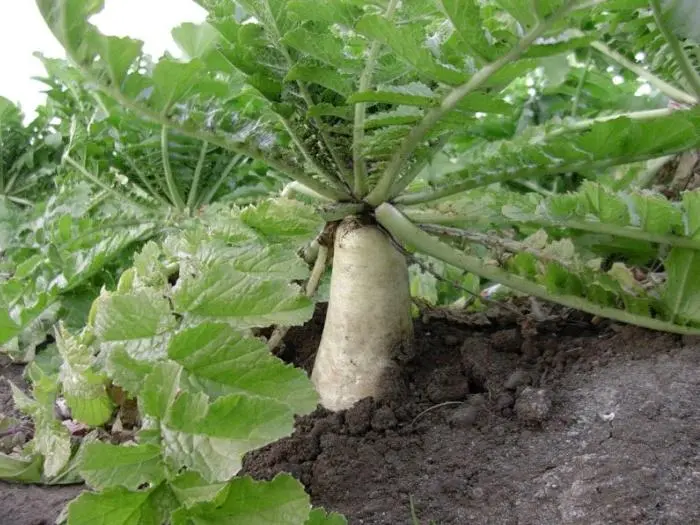
If necessary, top dressing is applied to the soil, this is easy to do simultaneously with watering. It is best to use complex mineral fertilizers, but you should not add organic matter, otherwise the radish will begin to branch. Wood ash, which is usually used to repel pests, will be an excellent fertilizer.
Mucous bacteriosis, clubroot, mosaic, felt disease, black leg – all these diseases of the radish can threaten its Japanese relative. The best prevention will be compliance with agrotechnical rules. So you need to follow the rules of crop rotation, treat the seeds before sowing a solution of potassium permanganate, not only weed the beds in a timely manner, but do not throw plant debris, but destroy, check the plants and, if possible, deal with pests that often carry diseases, do not overmoisten the soil.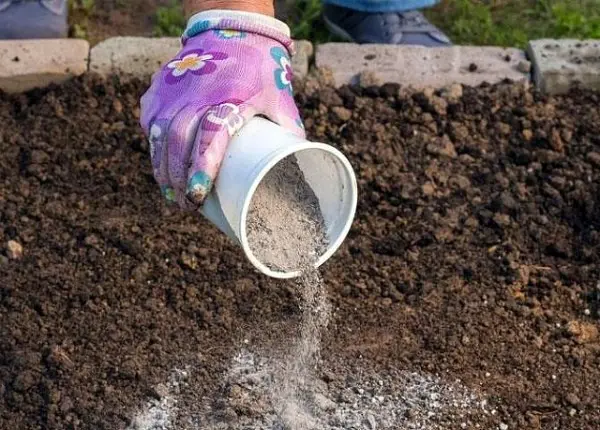
If fungal diseases have penetrated the garden, the use of biopreparations “Binoram” and “Planriz” will give a good result. It’s not so easy to get rid of the mosaic, you will have to destroy the affected plant, and thoroughly spill the hole and the ground around with a strong solution of potassium permanganate. Wood ash can scare away slugs, so it’s worth digging a small groove around the bed and filling it with ash, and if you fill it with earth, it can save you from cabbage fleas. Many harmful insects are repelled by the smell of marigolds; they can be planted around the perimeter of the garden. And if the insects nevertheless penetrated and are trying to lay larvae, then it is worth spraying the plants with an infusion of hot pepper and a weak solution of potassium permanganate.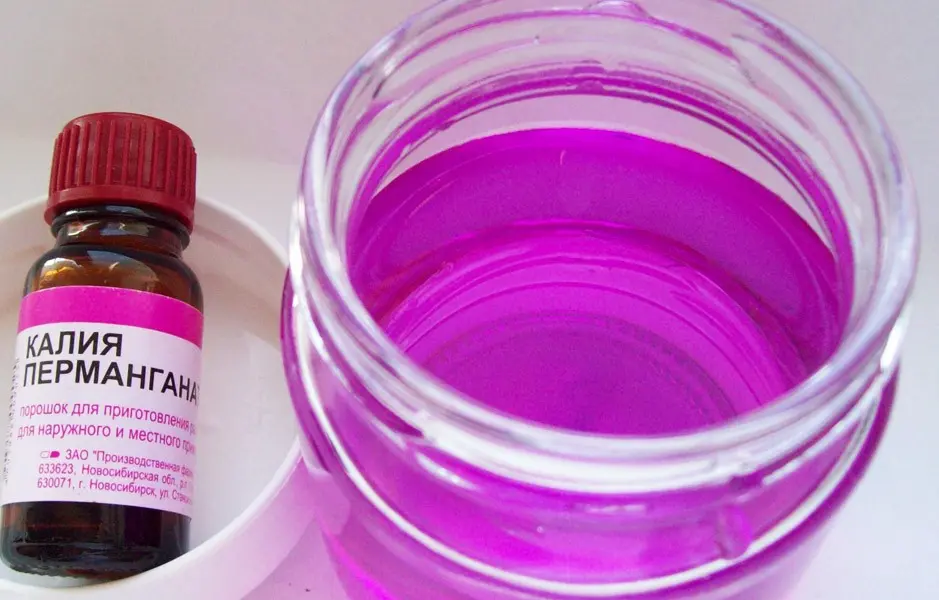
Harvest as it ripens, usually 60 or 70 days after sowing, choose a dry fine day for this. It is not worth leaving ripened root crops in the ground – in the summer the plant will go into the arrow and spoil the taste of the crop, and in the fall frosts will come. From light soil, long thick root crops are simply pulled out by the green hair, and if the soil is dense, it is better to use a pitchfork, a shovel is also possible, but there is a greater risk of injury. The extracted crop must be left right on the garden bed so that the earth adhering to it dries. If the sun is strong, then it is better to move it to the shade. It is not worth peeling off the ground – the skin of the root crop is very thin and tender, if it is injured, then it will no longer be stored.
If this is a winter radish, then the greens are cut off or cut off (unscrewed), very carefully sorted out, absolutely intact specimens are placed in boxes with wet sand, avoiding contact with each other, and taken to the cellar. At temperatures from + 1 to + 5, it will be perfectly stored almost all winter. Of course, the boxes and the entire cellar must be cleaned in advance of possible infection with the fungus. Another radish can be stored in separate plastic bags filled with sawdust or sand, you just need to make holes for air circulation.
Planting in the spring
If Minowashi is grown in greenhouses, then it can be sown in April, or even earlier, when the soil warms up enough. But it is necessary to plant in open ground as early as possible so that the period of root growth does not fall on a long daylight hours, but not earlier than the air temperature finally crosses the line of + 10 degrees. Such a fork is obtained, and in each locality it is necessary to get out of the climatic possibilities. In the middle lane, the last week of April is considered an approximate date, or rather summer residents begin to sow in the last week of April and finish in the first week of May. The main thing is that the earth allows the seeds to germinate, and agrofiber or film can save from a decrease in air temperature.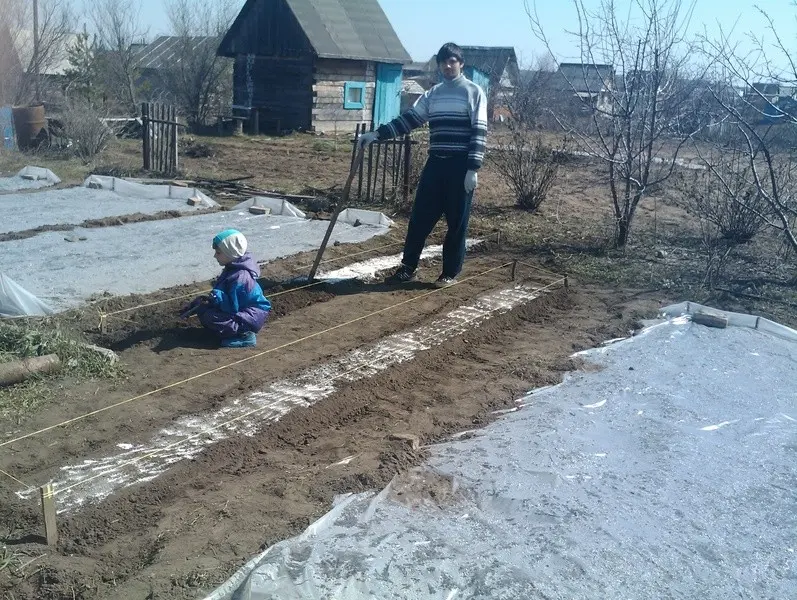
The seeds need to be prepared, for this they are dipped in very hot water (about 20 degrees) for 50 minutes, and after that – in ice water, then they are kept on the bottom shelf of the refrigerator for a day. Just before sowing, they are poured with a pink solution of potassium permanganate for disinfection.
On a bed prepared since autumn, rows are marked at a distance of at least 60 cm from each other, and 30 cm are left between the holes for plants. 2 or 3 seeds are lowered into each hole to a depth of 2 cm, fall asleep, tamped, watered. It is advisable to cover crops for several days with agrofibre to create a greenhouse effect. After 5 – 6 days, the shelter is removed, by this time the first shoots should appear. Young plants are watered. From now on, they need to be watered every five days, trying to moisten enough, but not excessively. A week later, a weak sprout is removed, leaving only one per hole, you don’t need to pull it out so as not to damage the one we want to leave, it’s better to just pinch off.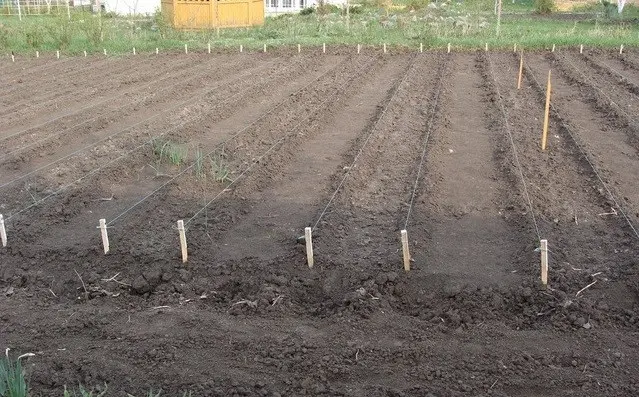
Since Minowashi has a very deep root, some gardeners for this crop do not fertilize from above. At the site of the future hole, with the help of a drill, a well is made about 60 cm deep and filled with fertile soil. Thus, they provide nutrition to the plant for the entire time of its growth. A very interesting way for such a deep rooting.
The spring planting crop is chosen from the beginning of July or a week or two earlier, it will not be possible to store it for a long time, so the root crops go straight to the table. One or two plants can be left or better dug up, dried, and then planted again to get their seeds. Before the autumn cold, they will have time to ripen.
Planting in autumn
Autumn or winter planting is actually done in late July or early August, when daylight hours are waning. So the planting turns out to be quite summer, but the harvest is chosen in the fall, it is it that is laid for long-term storage.
Radishes can be planted in a garden bed with lettuce, onions or dill removed. It’s good if organic matter has been introduced there since autumn, and mineral fertilizers can be applied right before the Daikon sowing. You need to prepare the seeds and plant them in the same way as in the spring, only there is no longer any need to close the crops from the cold. Sowing is usually done in well-moistened soil in rows to a depth of 2 cm. 60 cm is left between rows, and up to 30 between plants. After sowing, the earth is tamped and mulched with wet peat, the summer sun and mulch will create all the conditions for rapid seed germination. After the emergence of seedlings, they are thinned out, leaving one strong sprout in each hole.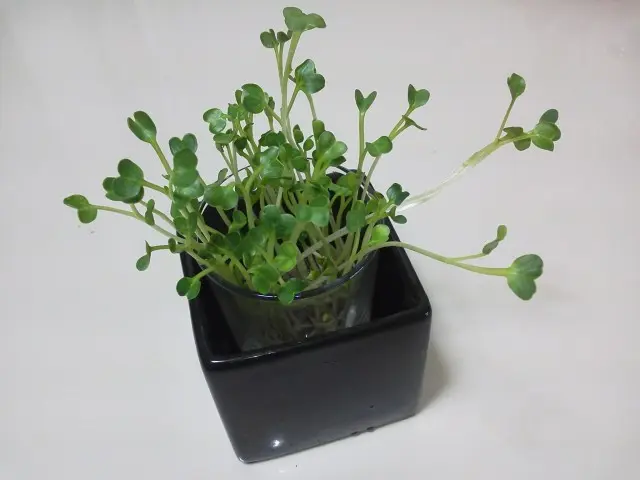
Some varieties of Minowashi give just giant root crops – up to 4 kg in weight, and so with the early arrival of autumn cold weather, they may simply not reach their maximum size – this is perhaps the only drawback of the autumn sowing of this vegetable, since the crop must be harvested so that it does not freeze . But the delicious snow-white turnips of this vegetable can be perfectly stored almost until spring, saving us from beriberi and seasonal colds, delighting us with a pleasant taste and diversifying the winter menu.
Video “How to grow Minowashi radish”
From this video you will learn how to harvest a good radish crop.









